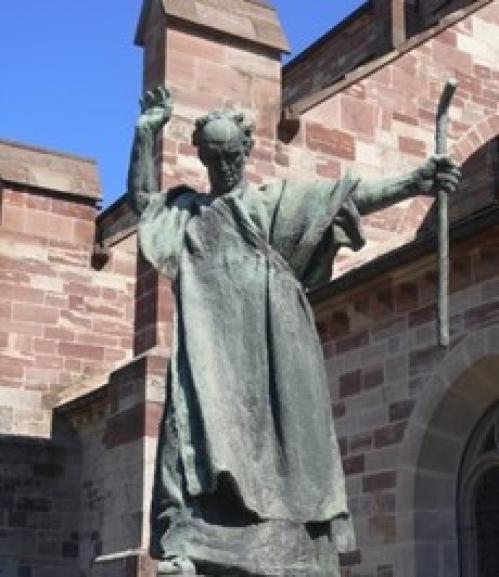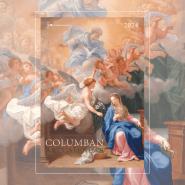 Statue of St Columban by Claude Grange at Luxeuil revealing Columban’s fierce side which he managed to combine with a gentle love of people, his monks and the natural world evident in most other images of him.
Statue of St Columban by Claude Grange at Luxeuil revealing Columban’s fierce side which he managed to combine with a gentle love of people, his monks and the natural world evident in most other images of him.
The opening prayer of the Mass for St Columban’s day says that Columban “wonderfully joined the work of evangelization to zeal for monastic life”. Columban was both a monk and a missionary. At one level these callings seem to move in opposite directions.
Being a monk generally involved moving away from people in search of solitude, seeking a quiet, deserted place in which to pray and reflect. Monasteries tended to be established in isolated places like the Aran Islands or in the deserts of Africa. Being a missionary, the other hand, involves moving towards people, going out to other places fulfilling the mandate given to the apostles by Jesus “go out to all the nations and proclaim the good news”. In the history of the church, it often happened that Christian communities grew up around someone seeking a contemplative life but who was drawn into becoming missionary by the needs of those around him. That is the story of Columban.
The Europe of Columban’s time had many needs. The old Roman empire had collapsed, and Europe was marked by wars, divisions and conflict. The Christian faith was in decline, in large part due to poor leadership by the bishops. Ireland on the other hand, though it was at the edge of the Roman empire and regarded as a barbarian nation, was undergoing a revolution. Like the monasteries that flourished there, Ireland was far from being insular. It had absorbed many influences from Africa and Europe including Greek and Roman classics and a great many radical new ideas, the most significant of which was Christianity. The monasteries in Ireland combined great scholarship and the creation of beautiful manuscripts with a rigorous, sometimes harsh, rule of life designed to nurture faith and spirituality. The rule of Columban was regarded as one of the toughest. Maybe because of the energy and vitality that marked their lives many young people came to join them so that new monasteries kept springing up. The barbarian nation was to become known as the island of saints and scholars.
When Columban went to France he arrived as a stranger in a foreign land bringing only his strength of personality, a vibrant spirituality, genuine scholarship and a band of dedicated monks. He also showed he had a talent for politics, negotiating with a local king for a plot of land in Annegray where he established his first monastery. Many more centres of learning were established, some estimates say as many as 100, which were to have a massive influence on Europe as it was in them that many of its future leaders were trained and formed.
It is believed that while his parents were mostly likely Christian, his grandparents were shaped by Celtic Spirituality. Columban would often retreat into lonely places and contemplate God in the natural world. He had absorbed the Celtic belief in sacred places and located some of his foundations near springs or ancient holy wells. Columban also brought with him a vision of unity in diversity learned from contemplating God is nature. He appealed to the leaders of Europe to work together, to focus on what they had in common rather than on what divided them. In July of 1950 at Luxeuil, the location of one of Columban’s early foundations, the seeds of what to become the European Union were planted during an event to celebrate 1400 years since the birth of Columban. Robert Schuman, the French Foreign Minister and a key figure in the movement acknowledged Columban as the father of Europe, the inspiration behind the idea of a United Europe.
When Ned Galvin, John Blowick and a few other Irish priests set up the Maynooth Mission to China they chose Columbans as its patron. Eventually it would become known as St Columban’s Mission Society. About this man, Tomas O’Fiaich in his book Columbanus in his Own Words says, “choosing solitude, he acquired great public influence, teaching humility, he found himself obliged to correct both popes and kings”. He goes on to say he was “a missionary through circumstance, a monk by vocation; a contemplative, too frequently driven to action by the world”.
In our world, which also has many needs and is increasing divided by wars and conflicts, Columban, with his ability to hold opposites in creative tension, to cherish both unity and diversity and his concern for people and nature is as relevant as ever.
Fr Patrick O'Shea - Lower Hutt, Aotearoa/New Zealand




Comments (0)